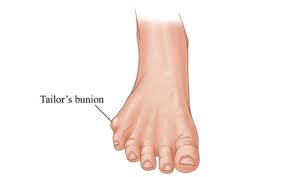
A tailor’s bunion, also known as a bunionette, is a painful bump that develops on the outside of the foot at the base of the little toe. It is similar to a regular bunion, which develops on the inside of the foot at the base of the big toe.
Tailor’s bunions are usually caused by an inherited structural abnormality in the foot that results in the little toe leaning inward, causing pressure and friction on the outside of the foot. Other factors that can contribute to the development of a tailor’s bunion include wearing tight or poorly fitting shoes, foot injuries, and arthritis.
Symptoms of a tailor’s bunion may include pain, swelling, redness, and a visible bump on the outside of the foot. Treatment for a tailor’s bunion may involve conservative measures such as wearing wider shoes, padding or cushioning the affected area, and taking non-steroidal anti-inflammatory drugs (NSAIDs) to reduce pain and inflammation. In severe cases, surgery may be necessary to correct the underlying structural problem and remove the bony bump.
Prevention of tailor’s bunions involves wearing comfortable, properly fitting shoes that provide enough room for the toes to move freely. Avoiding high heels and shoes with narrow toe boxes can also help reduce the risk of developing a tailor’s bunion. If you experience persistent foot pain or notice any unusual bumps or growths on your feet, it is important to seek medical attention to determine the underlying cause and receive appropriate treatment.
